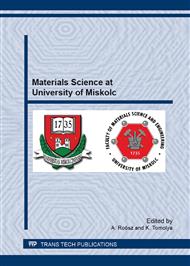[1]
Auerbach, S.M., K.A. Carrado, and P.K. Dutta, Handbook of zeolite science and technology, New York Marcel Dekker Inc., (2003).
Google Scholar
[2]
Mumpton, F.A., La roca magica: Uses of natural zeolites in agriculture and industry. Proceedings of the National Academy of Sciences of the United States of America 96 (7) (1999) 3463-3470.
DOI: 10.1073/pnas.96.7.3463
Google Scholar
[3]
Papaioannou, D., et al., The role of natural and synthetic zeolites as feed additives on the prevention and/or the treatment of certain farm animal diseases, Microporous and Mesoporous Materials 84(1-3) (2005) 161-170.
DOI: 10.1016/j.micromeso.2005.05.030
Google Scholar
[4]
Inoue, Y. and Y. Kanzaki, The mechanism of antibacterial activity of silver-loaded zeolite, Journal of Inorganic Biochemistry 67(1) (1997) 377-377.
DOI: 10.1016/s0162-0134(97)80243-7
Google Scholar
[5]
Cho, Y. -H., et al., Antibacterial effect of intraprostatic zinc injection in a rat model of chronic bacterial prostatitis, International Journal of Antimicrobial Agents 19(6) (2002) 576-582.
DOI: 10.1016/s0924-8579(02)00115-2
Google Scholar
[6]
Faundez, G., et al., Antimicrobial activity of copper surfaces against suspensions of Salmonella enterica and Campylobacter jejuni, BMC Microbiology 4(1) (2004) 19.
Google Scholar
[7]
Top, A. and S. Ülkü, Silver, zinc, and copper exchange in a Na-clinoptilolite and resulting effect on antibacterial activity, Applied Clay Science 27(1-2) (2004) 13-19.
DOI: 10.1016/j.clay.2003.12.002
Google Scholar
[8]
P. Kaali, Gy. Czél, Single, binary and ternary ion exchanged zeolite as an effective bioactive filler for biomedical polymer composites, Materials Science Forum 729 (2013) 234-239.
DOI: 10.4028/www.scientific.net/msf.729.234
Google Scholar
[9]
Adams, J.M., D.A. Haselden, and A.W. Hewat, The structure of dehydrated Na zeolite A by neutron profile refinement, Journal of Solid State Chemistry 44 (1982) 254-253.
DOI: 10.1016/0022-4596(82)90370-x
Google Scholar
[10]
Gellens, L.R., et al., The nature of charged silver clusters in dehydrated zeolites of type A, Journal of Physical Chemistry. 85 (1981) 2783-2788.
DOI: 10.1021/j150619a018
Google Scholar
[11]
Lee, H.S. and K. Seff, Redox reactions of copper in zeolite A. Four crystal structures of vacuum-desolvated copper-exchanged zeolite A, Journal of Physical Chemistry. 85 (1981) 397-410.
DOI: 10.1021/j150604a018
Google Scholar
[12]
Slatser, J.C., Atomic Radii in Crystals, Journal of Chemical Physics 41 (1964) 3199-3205.
Google Scholar
[13]
Shannon, R.H., Revised effective ionic radii and systematic studies of interatomic distances in halides and chalcogenides, Acta Crystallographica Section A: Foundations of Crystallography 32 (1976) 751-761.
DOI: 10.1107/s0567739476001551
Google Scholar
[14]
Kielland, J., Individual activity coefficients of ions in aqueous solutions, Journal of American Chemical Society 59 (1937) 1675-1678.
DOI: 10.1021/ja01288a032
Google Scholar


